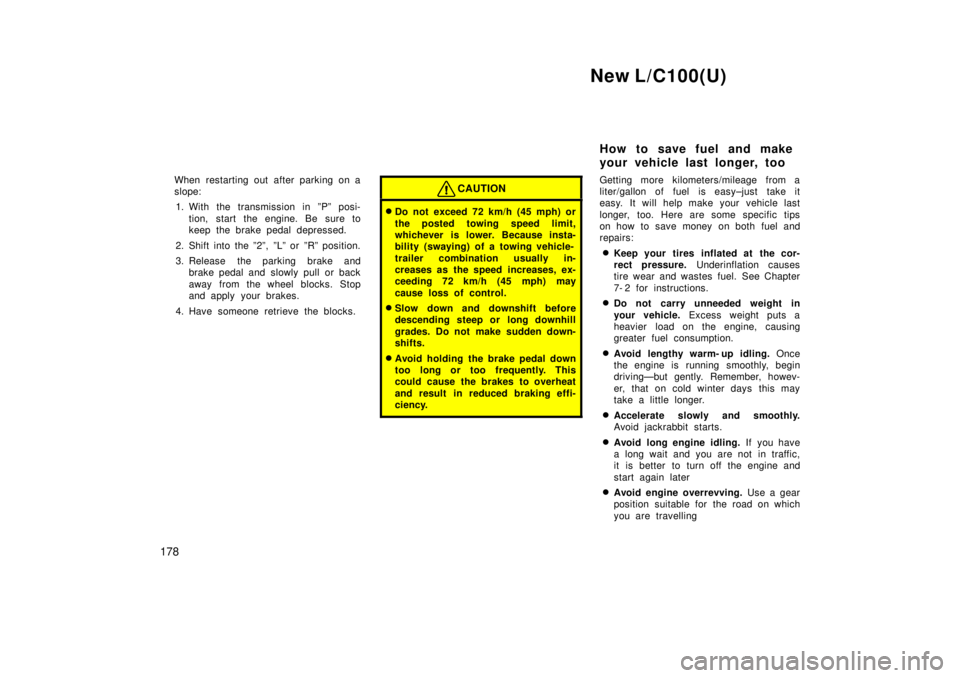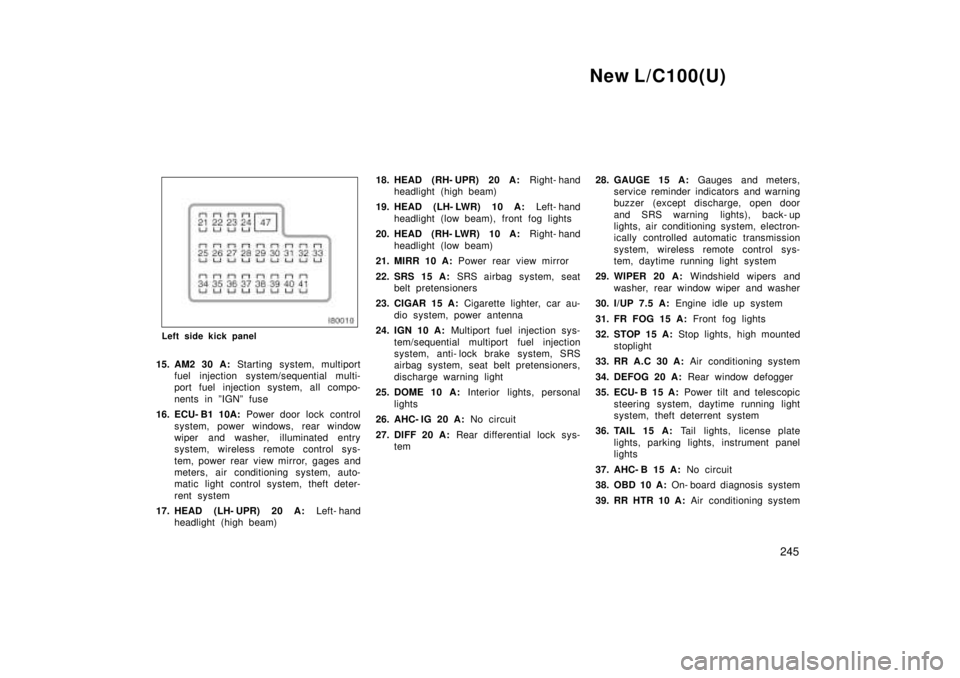1999 TOYOTA LAND CRUISER transmission
[x] Cancel search: transmissionPage 170 of 202

New L/C100(U)
178 When restarting out after parking on a
slope:
1. With the transmission in ºPº posi- tion, start the engine. Be sure to
keep the brake pedal depressed.
2. Shift into the º2º, ºLº or ºRº position.
3. Release the parking brake and brake pedal and slowly pull or back
away from the wheel blo cks. Stop
and apply your brakes.
4. Have someone retrieve the blo cks.
CAUTION
�Do not exceed 72 km/h (45 mph) or
the posted towing speed limit,
whichever is lower. Because insta-
bility (swaying) of a towing vehicle-
trailer combination usually in-
creases as the speed increases, ex-
ceeding 72 km/h (45 mph) may
cause loss of control.
� Slow down and downshift before
descending steep or long downhill
grades. Do not make sudden down-
shifts.
� Avoid holding the brake pedal down
too long or too frequently. This
could cause the brakes to overheat
and result in reduced braking effi-
ciency.
Getting more kilometers/mileage from a
liter/gallon of fuel is easy±just take it
easy. It will help make your vehicle last
longer, too. Here are some specific tips
on how to save money on both fuel and
repairs:
� Keep your tires inflated at the cor-
rect pressure. Underinflation causes
tire wear and wastes fuel. See Chapter
7- 2 for instructions.
� Do not carry unneeded weight in
your vehicle. Excess weight puts a
heavier load on the engine, causing
greater fuel consumption.
� Avoid lengthy warm- up idling. Once
the engine is running smoothly, begin
drivingÐbut gently. Remember, howev-
er, that on cold winter days this may
take a little longer.
� Accelerate slowly and smoothly.
Avoid jackrabbit starts.
� Avoid long engine idling. If you have
a long wait and you are not in traffic,
it is better to turn off the engine and
start again later
� Avoid engine overrevving. Use a gear
position suitable for the road on which
you are travelling
How to save fuel and make
your vehicle last longer, too
Page 182 of 202

New L/C100(U)
210
Automatic transmission ºParkº mecha-
nism
Check the lock release button of the se-
lector lever for proper and smooth opera-
tion. On a safe incline, check that your
vehicle is held securely with the selector
lever in ºPº position and all brakes re-
leased.
IN THE ENGINE COMPARTMENT
Items listed below should be checked
from time to time, e.g. each time when
refueling.
Washer fluid
Make sure there is sufficient fluid in the
tank. See Chapter 7- 3 for additional in-
formation.
Engine coolant level
Make sure the coolant level is between
the ºFULLº and ºLOWº lines on the see-
through reservoir when the engine is cold.
See Chapter 7- 2 for additional information.
Battery electrolyte level
Make sure the electrolyte level of all bat-
tery cells is between upper and lower lev-
el lines on the case. Add only distilled
water when replenishing. See Chapter 7- 3
for additional information.
Brake fluid level
Make sure the brake fluid level is correct.
See Chapter 7- 2 for additional information.
Engine oil level
Check the level on the dipstick with the
engine turned off and the vehicle parked
on a level spot. See Chapter 7- 2 for addi-
tional information.
Power steering fluid level
Check the level through the reservoir. The
level should be in the ºHOTº or ºCOLDº
range depending on the fluid temperature.
See Chapter 7- 2 for additional information.
Exhaust system
If you notice any change in the sound of
the exhaust or smell exhaust fumes, have
the cause located and corrected immedi-
ately. (See engine exhaust cautions in
Part 2.)
Be on the alert for changes in perfor-
mance, sounds, and visual tip- offs that
indicate service is needed. Some impor-
tant clues are as follows:
� Engine missing, stumbling, or pinging
� Appreciable loss of power
� Strange engine noises
� A leak under the vehicle (however, wa-
ter dripping from the air conditioning
after use is normal.)
� Change in exhaust sound (This may
indicate a dangerous carbon monoxide
leak. Drive with the windows open and
have the exhaust system checked im-
mediately.)
� Flat- looking tire; excessive tire squeal
when cornering; uneven tire wear
� Vehicle pulls to one side when driving
straight on a level road
� Strange noises related to suspension
movement
� Loss of brake effectiveness; spongy
feeling brake pedal; pedal almost
touches floor; vehicle pulls to one side
when braking
� Engine coolant temperature continually
higher than normal
Does your vehicle need
repairing?
Page 189 of 202

New L/C100(U)217
NOTICE
�Remember that battery and ignitioncables carry high currents or volt-ages. Be careful of accidentally causing a short circuit.
�Add only demineralized or distilledwater to fill the radiator. And if you spill some of the coolant, be sure
to wash it off with water to preventit from damaging the parts or paint.
�Do not allow dirt or anything elseto fall through the plug holes.
�Do not pry the outer electrode of a
spark plug against the center elec-trode.
�Use only spark plugs of the speci-fied type. Using other types will cause engine damage, loss of per-
formance or radio noise.
�Do not reuse iridium- tipped sparkplugs by cleaning or regapping.
�Do not overfill automatic transmis-sion fluid, transfer oil and power
steering fluid, or the transmission,transfer and power steering couldbe damaged.
�Do not drive with the air cleaner
filter removed, or excessive enginewear could result. Also backfiringcould cause a fire in the engine
compartment.
�Be careful not to scratch the glasssurface with the wiper frame.
�When closing the engine hood,check to see that you have not for-
gotten any tools, rags, etc.
Parts and tools
Here is a list of parts and tools you will
need on performing do- it- yourself mainte-
nance. Remember all Toyota parts are de-
signed in metric sizes, so your tools must
be metric.
Checking the engine oil level
Parts (if level is low):
� Engine oil API grade SJ,
ºEnergy- Conservingº multigrade or
ILSAC multigrade having viscosity
proper for your climate
Tools: � Rag or paper towel
� Funnel (only for adding oil)
Checking the engine coolant level
Parts (if level is low): � ºToyota Long Life Coolantº or equiva-
lent
See Chapter 7- 2 for details about cool-
ant type selection.
� Demineralized or distilled water
Tools:
� Funnel (only for adding coolant)
Page 190 of 202

New L/C100(U)
218
Checking brake fluid
Parts (if level is low):
� SAE J1703 or FMVSS No.116 DOT 3
brake fluid
Tools:
� Rag or paper towel
� Funnel (only for adding fluid)
Checking power steering fluid
Parts (if level is low):
Automatic transmission fluid DEXRON �
II
or III
Tools:
� Rag or paper towel
� Funnel (only for adding fluid)
Checking battery condition
Tools: � Warm water
� Baking soda
� Grease
� Conventional wrench (for terminal
clamp bolts) Checking and replacing fuses
Parts (if replacement is necessary):
� Fuse with same amperage rating as
original
Adding washer fluid
Parts: � Water
� Washer fluid containing antifreeze (for
winter use)
Tools: � Funnel
Replacing light bulbs
Parts:
� Bulb with same number and wattage
rating as original (See charts in ºRe-
placing light bulbsº in Chapter 7- 3.)
Tools:
� Screwdriver
Page 193 of 202

New L/C100(U)243
AUTOMATIC TRANSMISSION
Fluid capacity (drain and ref
ill), L (qt.,
Imp. qt.)
Up to 3.5 (3.7, 3.1)
Fluid type: Automatic transmission fluid D±II or DEXRON �
III (DEXRON �
II)
TRANSFER
Oil capacity, L (qt., Imp. qt.) 1.3 (1.4, 1.1)
Oil type: Gear oil API GL- 4 or GL- 5
Recommended oil viscosity: SAE 75W- 90
DIFFERENTIAL
Oil capacity, L (qt., Imp. qt.): Front 1.7 (1.8, 1.5) Rear
With rear differential lock system
3.2 (3.4, 2.8)
Without rear differential lock system 3.3 (3.5, 2.9) Oil type:
Standard differential Hypoid gear oil API GL- 5
Limited slip differential Hypoid gear oil for limited slip differ-
ential API GL- 5
Recommended oil viscosity: Above -18 �C (0 �F)
SAE 90
Below -18 �C (0 �F)
SAE 80W or 80W- 90
CHASSIS LUBRICATION
Wheel bearings: Lithium base wheel bearing grease,
NLGI No.2
Front drive shaft thrust bushings: Synthetic oil and lithium soap base
chassis grease, NLGI No.1
Propeller shafts: Lithium base wheel bearing grease,
NLGI No.2 BRAKES
Minimum pedal clearance when depressed
with the pressure of 490 N (50 kgf, 110
lbf) with the engine running, mm (in.):
116 (4.6)
Pedal freeplay, mm (in.): 1Ð6 (0.04Ð0.24)
Pad wear limit, mm (in.):
1.0 (0.04)
Lining wear limit, mm (in.): 1.0 (0.04)
Parking brake adjustment when pulled with
the force of 196 N (20 kgf, 44 lbf): 4Ð6 clicks
Fluid type: SAE J1703 or FMVSS No.116 DOT 3
STEERING
Wheel freeplay: Less than 40 mm (1.6 in.)
Power steering fluid type: Automatic transmission fluid DEXRON �
II
or III
Page 195 of 202

New L/C100(U)245
Left side kick panel
15. AM2 30 A: Starting system, multiport
fuel injection system/sequential multi-
port fuel injection system, all compo-
nents in ºIGNº fuse
16. ECU- B1 10A: Power door lock control
system, power wi ndows, rear window
wiper and washer, illuminated entry
system, wireless remote control sys-
tem, power rear view mirror, gages and
meters, air conditioning system, auto-
matic light control system, theft deter-
rent system
17. HEAD (LH- UPR) 20 A: Left- hand
headlight (high beam) 18. HEAD (RH- UPR) 20 A:
Right- hand
headlight (high beam)
19. HEAD (LH- LWR) 10 A: Left- hand
headlight (low beam), front fog lights
20. HEAD (RH- LWR) 10 A: Right- hand
headlight (low beam)
21. MIRR 10 A: Power rear view mirror
22. SRS 15 A: SRS airbag system, seat
belt pretensioners
23. CIGAR 15 A: Cigarette lighter, car au-
dio system, power antenna
24. IGN 10 A: Multiport fuel injection sys-
tem/sequential multiport fuel injection
system, anti- lock brake system, SRS
airbag system, seat belt pretensioners,
discharge warning light
25. DOME 10 A: Interior lights, personal
lights
26. AHC- IG 20 A: No circuit
27. DIFF 20 A: Rear differential lock sys-
tem 28. GAUGE 15 A:
Gauges and meters,
service reminder indicators and warning
buzzer (except discharge, open door
and SRS warning lights), back- up
lights, air conditioning system, electron-
ically controlled automatic transmission
system, wireless remote control sys-
tem, daytime running light system
29. WIPER 20 A: Windshield wipers and
washer, rear window wiper and washer
30. I/UP 7.5 A: Engine idle up system
31. FR FOG 15 A: Front fog lights
32. STOP 15 A: Stop lights, high mounted
stoplight
33. RR A.C 30 A: Air conditioning system
34. DEFOG 20 A: Rear window defogger
35. ECU- B 15 A: Power tilt and telescopic
steering system, daytime running light
system, theft deterrent system
36. TAIL 15 A: Tail lights, license plate
lights, parking lights, instrument panel
lights
37. AHC- B 15 A: No circuit
38. OBD 10 A: On- board diagnosis system
39. RR HTR 10 A: Air conditioning system
Page 202 of 202

New L/C100(U)Publication No. OM60811U
Part No. 01999-60811
Printed in Japan 01- 9810- 00
(U)
Quick index
� If a service reminder indicator or warning buzzer comes on 94 . . . . .
� If your vehicle will not start 181
. . . . . . . . . . . . . . . . . . . . . . . . . . . . . . . . . . .
� If your engine stalls while driving 185 . . . . . . . . . . . . . . . . . . . . . . . . . . . . . .
� If your vehicle overheats 185
. . . . . . . . . . . . . . . . . . . . . . . . . . . . . . . . . . . . . .
� If you have a flat tire 186
. . . . . . . . . . . . . . . . . . . . . . . . . . . . . . . . . . . . . . . . .
� If your vehicle needs to be towed 195 . . . . . . . . . . . . . . . . . . . . . . . . . . . . .
� Tips for driving during break-in period 152 . . . . . . . . . . . . . . . . . . . . . . . . . .
� How to start the engine 167
. . . . . . . . . . . . . . . . . . . . . . . . . . . . . . . . . . . . . . .
� General maintenance 208
. . . . . . . . . . . . . . . . . . . . . . . . . . . . . . . . . . . . . . . . . .
� Complete index NO TAG
. . . . . . . . . . . . . . . . . . . . . . . . . . . . . . . . . . . . . . . . . .
Gas station information
Fuel type: Premium UNLEADED gasoline, Octane Rating 91 (Research Octane
Number 96) or higher for optimum engine performance However, if
such premium type cannot be obtained, you may temporarily use
unleaded gasoline with an Octane Rating as low as 87 (Research
Octane Number 91).
See page 153 for detailed information.
Fuel tank capacity: 96 L (25.4 gal., 21.1 lmp. gal.)
Engine oil:
API grade SJ, ºEnergy- Conservingº multigrade engine oil or ILSAC
multigrade engine oil is recommended.
See page 220 for detailed information.
Automatic transmission fluid: Automatic transmission fluid D- II or DEXRON �
III (DEXRON �
II)
Tire information: See pages 224 through 228.
Tire pressure: See page 244.
U�3
I